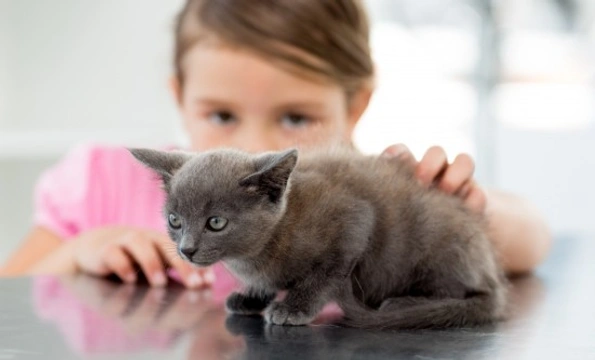
Cats and Kids
Children get very attached to a family cat but it's important for younger members to understand a little bit about our feline friends. Independent and less demanding than a dog, cats still need to be well cared for and handled gently which small people very often need to be taught how to do. Toddlers should never be left alone with a cat or any other pet, not until they are old enough to understand how to approach them, what scares them and what to avoid doing to them so they don't get bitten or scratched.
Teaching Kids About the History of Cats
It's a nice idea to teach the kids a little bit about the history of cats and how their big cousins which includes lions and tigers have the same prehistoric ancestors. Another interesting point is that our feline friends were the ones that decided to live with humans, it was not people who first domesticated the cat. In fact, cats have a fascinating ancestry which goes way back to prehistoric times which is as follows:
- The first ever carnivores that looked like cats were around 20 million years ago
- The first known relative to our domestic cats appeared 12 million years ago
- It was in ancient Egypt back in 4000 BC when African wildcats first started going into towns to look for food in the form of rats that lived in grain stores. An ample supply of food meant the cats remained in the towns and therefore close to people
- Around 2000 BC Egyptian people welcomed cats into their homes because our feline friends helped keep rats and snakes away. Egyptians even began worshipping them and they became sacred animals which were not allowed to be taken out of Egypt
- It was around 1000 BC right through till 500 BC that cats started to appear all across south east Asia and India. These felines were usually smuggled out of Egypt to new places where they would be sold
- By 500 AD, the Romans had introduced cats to Europe and this included England when they invaded the land. As the Roman Empire got bigger, more cats were introduced to new places around Europe and other parts of the world where the Romans formed settlements
- Although revered by the Egyptians, it was not the same in other parts of the world and in the 1400s cats became associated with witches and as such they were treated very badly and very often killed
- It was in the 1700s that American settlers took lots of cats with them over to the New World and they did this so they could control rat populations in regions of the country they decided to settle in. Once cats were introduced into America, they soon spread all through the land
- By the 1800s, cats were becoming very popular pets in the UK and in 1871, the first ever cat show was held in London
- During the First World War, cats played their part in helping soldiers in the trenches where they sniffed out any poisonous gas that might be present. They were also taken on war ships because they were such good ratters helping to keep rodent populations down
- In 1927, the Cats Protection was founded as a way to teach people all about cats and how to look after them. Later on, the society started to rescue and help re-home cats to loving and caring homes
- Cats became one of the most popular pets in the UK during the 2000s when it was established that over 9 million of our feline friends were kept as pets all over the country. The reason cats became so popular is because they are loving creatures but they are also such independent characters too
Teaching Your Children to Play Nicely
As any cat owner knows, their pets really enjoy play time"" both when they are kittens and as adults too. Kittens learn lots when they play and it's these skills which help them get through the rest of their lives in a relaxed way. However, it's important to teach children how to play with their pet so that nobody gets scared, scratched or bitten and this goes for the kids and the cat.
It's important to show kids that cats love certain toys and especially when they move so they can chase them. Attaching a toy to a length of string and dragging it around is a great way of getting a cat to chase it and to play with the toy. Teaching the kids that they can play with a family cat without picking them up or being too close so they end up getting a scratch or two is really important and using a piece of string is a great way of making sure there's enough distance between fingers and claws!
Conclusion
Cats make wonderful family pets, they are affectionate, loving and loyal. Children get very attached to our feline friends but it's important to teach younger kids how to behave around them. Toddlers should never be left on their own with a cat or any other animal because they don't know how to stroke or play with them which could result in them getting bitten or scratched. Teaching the kids about the history of a family cat can be made into a lot of fun and showing them how to play and handle a furry feline friend will help prevent anything untoward from happening.
""



